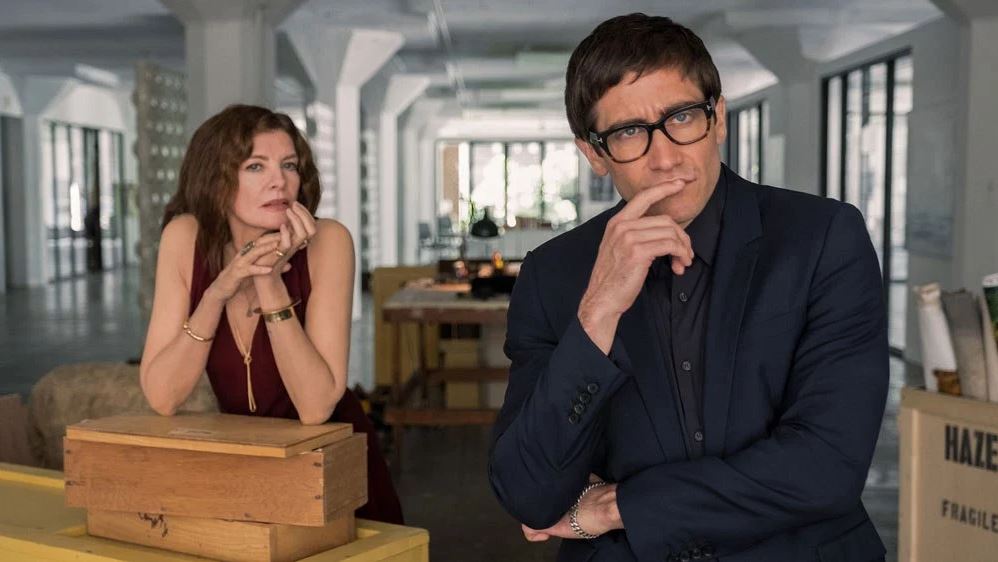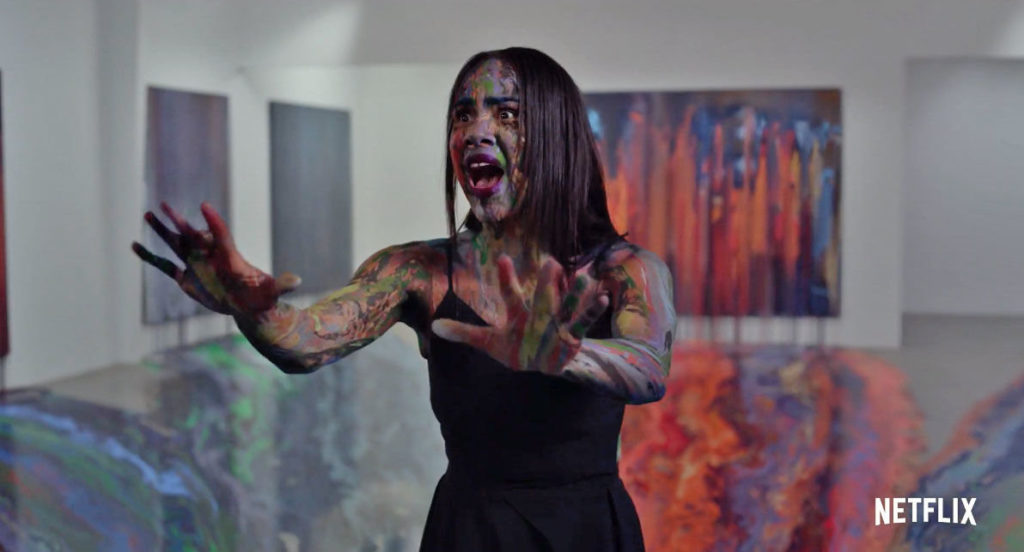
The emperor’s clothes get ripped to shreds in Velvet Buzzsaw, an asinine satire of the modern art scene that paints its targets and its characters in crude, bloody strokes. Written and directed by Dan Gilroy (and distributed by Netflix), it imagines a world full of rubes and sharks, a corrupt ecosystem in which artists, dealers, and critics conspire and compete in their feverish efforts to defraud you, the guileless consumer. It’s a tale of sickly glamour; most of the people we meet in this ugly little movie are extremely wealthy, though their morals are as bankrupt as Gilroy’s themes.
As a satire, Velvet Buzzsaw is profoundly idiotic, but as a halfway-intentional comedy, it is not without its diversions. Chief among those is Jake Gyllenhaal, who in Gilroy’s Nightcrawler delivered the performance of his career as a gaunt, wild-eyed videographer who crept from TV newsrooms into your nightmares. His work here is less unsettling but no less entertaining, full of rococo flourishes that underline his zany commitment. His mania holds your attention even as the film around him burns to the ground.
Gyllenhaal’s protagonist, who bears the spectacular name of Morf Vandewalt, is a preposterously influential art critic who roves about Los Angeles, constantly judging paintings and people alike. With a withering gaze that he casts through severe Tom Ford glasses, Morf seems to be addicted to the discipline of criticism, operating with a veneer of ingratiating politeness that he occasionally drops to deliver an arch putdown. When he arrives at a funeral for a former colleague, the first thing he does is mock the color of the casket. “What is that, smog orange?” he scoffs, to the disgust of his companion.

That would be Joesphina (Zawe Ashton, who had a small part in Ford’s Nocturnal Animals), and while Morf is the most pathetic character in Velvet Buzzsaw, she isn’t much better. In fact, pretty much everyone we meet is some combination of selfish, rude, and predatory, Gilroy’s implication being that in the dog-eat-dog LA art scene, success is fleeting and can only be achieved through backstabbing and manipulation. Josephina is a harried assistant at a high-end gallery, where she ducks the flirtations of a muscular staffer, Bryson (Billy Magnussen), while straining to please her demanding boss, Rhodora (Rene Russo), who doesn’t tolerate tardiness or mistakes. Rhodora is busy courting an up-and-coming artist named Damrish (Daveed Diggs), while one of her competitors, Jon (Tom Sturridge), plots to poach one of her longest-tenured clients, Piers (John Malkovich). Rhodora and Morf are not quite friends, but their shared sense of superiority allows them to chortle and wince in haughty harmony; the same is true of Morf and Gretchen (Toni Collette), a museum curator with platinum hair who’s always looking for the latest scoop.
The names in those parentheticals are all good actors, but Gilroy has no interest in letting them build three-dimensional characters. He is instead focused on lampooning an industrial complex that, in his view, is founded on duplicity, superficiality, and grift. “We peddle perception,” Rhodora declares, and her mantra illuminates Gilroy’s banal thesis: that art has no inherent value but is only worth what people say it’s worth. Everyone has scales on their eyes, which means that nobody is interested in truth. As an example, when Jon arrives at Piers’ studio, he admires an arrangement of garbage bags, only for Piers to inform him that he’s looking at actual trash and that the real canvas is over there.
Did you laugh? I did. But while Gilroy’s cynicism allows Velvet Buzzsaw to be sporadically funny—even if the humor is shallow and toothless—to the extent that he’s trying to make a serious point, his ideas are facile and noxious. In positing the art world as a subculture that subsists entirely on greed and deception, he frames all of its denizens as venal accomplices, all engaged in the same conspiracy of hoodwinking the witless public. And so, critics such as Morf aren’t true enthusiasts; instead, they’re powerful cogs who must be greased, feared, and placated. Only then can exhibitors sell the paintings which they commission from narcissistic artists who glumly stare at blank canvases, and who have completely lost touch with The Common Man.

The bleakly comic scene that best enunciates Velvet Buzzsaw’s toxic worldview comes when a woman’s lifeless body is found on the floor of a new exhibit. Rather than call for help, the oblivious patrons assume that the corpse is a part of the installation, some sort of ingenious metaphor. What imbeciles!
To be fair to Gilroy, he does not do things halfway. Having established this community as a powder keg of skullduggery and smarm, he then sets it ablaze with the death of Vetril Dease, Josephina’s upstairs neighbor. Wandering into the dead man’s apartment, Josephina discovers a cache of paintings that prove to be shattering in their grotesque originality (Morf describes them as “mesmeric”). Never concerned with letting scruples interfere with profit, Josephina teams up with Rhodora to start exhibiting Dease’s work—Morf gobbles up the rights to a book—and together they set the contemporary art scene on fire. Sometimes literally.
To describe the trajectory that Velvet Buzzsaw follows would risk both spoiling its surprises and sounding completely insane. Suffice it to say that the film has less in common with Basquiat or Pollock than with A Nightmare on Elm Street, repeatedly placing its characters in predicaments of gory peril. In this regard, Gilroy flaunts a facility for innovative mayhem, staging a handful of deadly dilemmas with bravado and wit. He seems more than capable of making a pretty good, straightforward horror movie.

But that would likely prove too chancy for the director, who here swaddles his work in a protective coating of winking sarcasm. To criticize Velvet Buzzsaw—to castigate its flimsiness, to reject its smugness, to bemoan its absurdity—is to fall into its trap. The film has studiously insulated itself against the possibility of genuine criticism, because disapproving of it only means that you’re taking it too seriously. To dislike it is to be like Morf.
I prefer to equate myself to Coco (Natalia Dyer, best known as Nancy on Stranger Things), the helpless gofer who keeps getting shunted from one gallery owner to the next, and who absorbs the movie’s escalating chain of events with mounting disbelief and dismay. Coco is the only sympathetic presence in Velvet Buzzsaw—she just wants a damn job so that she can pay her rent—and when Dyer is on screen, a glimmer of humanity threatens to break through the fog of spite and condescension.
But Gyllenhaal remains the movie’s dominant presence, and it is his caricatured critic whom Gilroy most enjoys attacking. At one point, on Josephina’s request, Morf writes a scathing critique of her ex-boyfriend’s show; shortly thereafter, that same ex-boyfriend gets drunk and crashes his car. “He was crushed,” a woman tells Morf somberly.
“By the car?”
“Your review!”
That’s another funny exchange, but it also betrays Velvet Buzzsaw’s fundamental misunderstanding of cause and effect. In art, and at the movies, the car crash tends to come first.
Grade: C
Jeremy Beck is the editor-in-chief of MovieManifesto. He watches more movies and television than he probably should.
